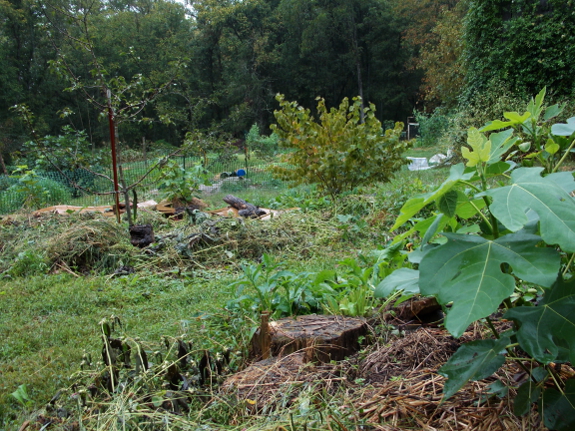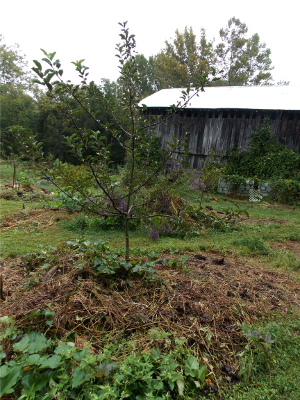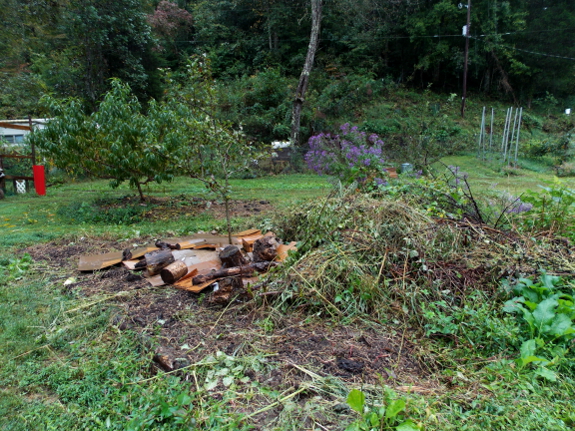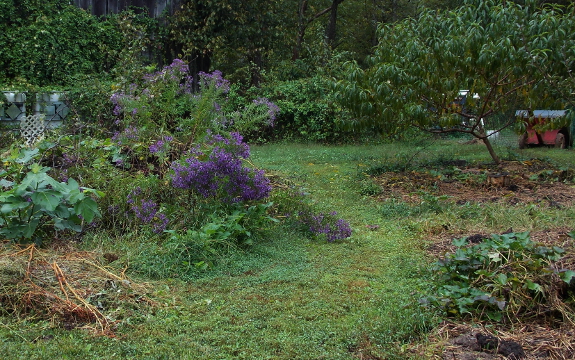
Building soil in the forest garden

 Long-time readers will recall that my young
forest garden
sits in an area where all of the topsoil has eroded away and where
the groundwater pools right at the surface during wet
seasons. My solution to this extremely-troubled growing area
is create my own topsoil, raising the trees' roots up out of the
groundwater as quickly as I can.
Long-time readers will recall that my young
forest garden
sits in an area where all of the topsoil has eroded away and where
the groundwater pools right at the surface during wet
seasons. My solution to this extremely-troubled growing area
is create my own topsoil, raising the trees' roots up out of the
groundwater as quickly as I can.
As you can see in the photo above, sometimes that's not quickly
enough. The apple tree in the worst part of the forest
garden had to be staked this year because it had no place to put
taproots, resulting in a leaning trunk. In contrast, its
age-mate to the right is thriving in the slightly-better soil not
far away.
This long
introduction is all to explain why, over the last few years, I've
been focusing most of my forest-gardening energy on building
biomass, with some techniques working better than others. My
hugelkultur
donuts were the
best option, but they depend on masses of punky firewood and we've
been doing a better job lately of making sure our firewood stays
dry and gets burned. So I've instead been growing cover
crops (like sweet
potatoes) just
past the root zone of my fruit trees, then piling up the biomass
around the trees' roots to rot down into organic matter, building
soil while feeding the trees.

And then there's my brush
pile, shown to
the right in the photo above. All of the prunings from
berries and trees across our homestead end up in this pile, which
reaches over my head during pruning season but slowly rots down to
a gentle mound by this time of year. (Right now, the pile is
also topped by yanked-up cover crops and weeds from the
surrounding bed.)
You can also see how I kill-mulched under most of the fruit trees
last week to ensure they don't have to compete with weeds during
their fall-feeding
window, then
cleared ground further away to plant rye for winter biomass
production.

The result of all of
this biomass growing is happy trees covering two-thirds of the
forest garden. The last third just needs a little more TLC
before the soil is dry enough to really keep cover crops happy, at
which point the soil-improvement cycle will take off nearly by
itself. That area is where I'll concentrate any punky wood I
rustle up this winter. I seem to recall a couple of piles of
firewood in the floodplain that didn't get collected last winter
and are probably ripe for hugelkultur right about now....
Want more in-depth information? Browse through our books.
Or explore more posts by date or by subject.
About us: Anna Hess and Mark Hamilton spent over a decade living self-sufficiently in the mountains of Virginia before moving north to start over from scratch in the foothills of Ohio. They've experimented with permaculture, no-till gardening, trailersteading, home-based microbusinesses and much more, writing about their adventures in both blogs and books.
Want to be notified when new comments are posted on this page? Click on the RSS button after you add a comment to subscribe to the comment feed, or simply check the box beside "email replies to me" while writing your comment.

Three questions, please.
What do you mean by "raising the roots" out of the ground? Did you plant the tree in a raised mound and if so, what was the mound comprised of?
Second, do you throw weed clippings into your mulch pile or only brush? I'm never sure what to do with weeds because I'm a lazy composter and just throw things in a pile so I'm assuming I never get my pile hot enough to sterilize weeds.
Third, what is that pretty purple flower that looks sort of like ironweed?
Thanks so much!
Karyn --- I start the trees in raised beds consisting of whatever I have on hand --- soil, manure, rotting wood, etc. Then I expand those mounds in the ways I've been discussing in this post. My goal is to build new soil high enough up that it's not always waterlogged.
I do throw weed clippings in these piles, and some seeds (and roots) grow. But the piles aren't right at the base of the trees (unless they consist only of cover crops with no weeds or viable roots), so if something grows, I just toss more weeds on top. Eventually, most weeds die. I wouldn't be so lazy if I was tossing my weed piles in the vegetable garden, but I figure the trees can take it. Depending on who needs it more, though, I sometimes toss the weeds into our chicken coops to refresh the deep bedding (and let the flock eat the seeds). And if too many weeds sprout up from one of my mulch piles, I'll throw a layer of cardboard on top to calm things back down.
I wouldn't be so lazy if I was tossing my weed piles in the vegetable garden, but I figure the trees can take it. Depending on who needs it more, though, I sometimes toss the weeds into our chicken coops to refresh the deep bedding (and let the flock eat the seeds). And if too many weeds sprout up from one of my mulch piles, I'll throw a layer of cardboard on top to calm things back down.
The purple flower is New England aster, which I got from my mom. In her city yard, it attracts bees like crazy, which is why I put it in, but here, there are so many wildflowers around that it's not quite as much of a mecca for pollinators. Still, it's pretty, so I let it bush out and come back every year.
My attitude about keeping weed seeds out of the compost pit is like my attitude about cleaning the chicken coop: even if you could sterilize it, it wouldn't stay sterilized for long. Good enough is good enough. The beneficial biomass from abundant weeds outweighs the detriment of a few seeds which seem to inevitably find their way to the garden anyways.
Weeds,snakes & spiders need love too
Thanks for the help, Anna and Doc. I'm curious about the tree planting because I have a spot where most of the water of the property runs and would love to plant something to help with erosion. I never thought of a hugelkulture mound for a tree (I've only seen the models for raised veggie beds and don't know why I didn't think to use it in other instances).
I now I will joyfully throw the weeds into the compost!